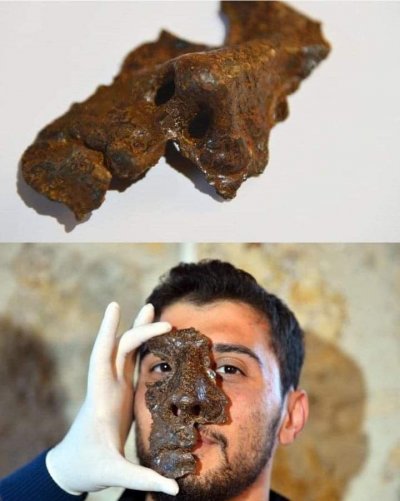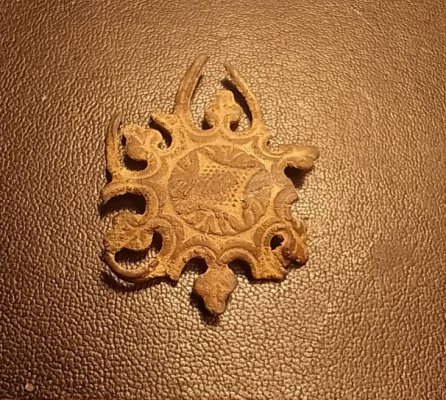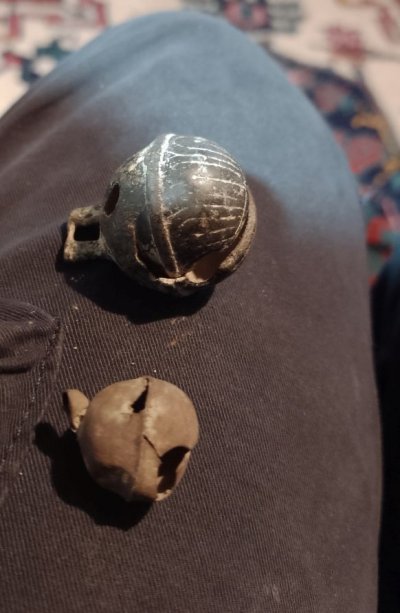You are using an out of date browser. It may not display this or other websites correctly.
You should upgrade or use an alternative browser.
You should upgrade or use an alternative browser.
Metal Detectoring
- Thread starter Ginando
- Start date
Druk
Abominable Snowman
- Joined
- Sep 14, 2023
- Messages
- 550
Seaham beach is perfect for seaglass.This might be the right place for this. On the other hand... it might not!
Item from The National about looking for seaglass. Beachcombing and field walking. For those of us who need a point to a walk!
You can find all sorts of goodies in littoral areas.
https://www.thenational.scot/cultur...=1db37e164456d8e1830da3d4ed866ce9&date=030224
View attachment 73585
Sollywos
Studying for finals of Grumpy Old Lady degree.
- Joined
- Dec 23, 2018
- Messages
- 1,335
- Location
- In the enchanted library.
I'm assuming the ones in the illustration are buttons as I think have some like the red and orange ones in the bottom of the picture in my button box. some of the others look familiar as wellYou can find all sorts of goodies in littoral areas.
kesavaross
Justified & Ancient
- Joined
- Oct 18, 2015
- Messages
- 1,950
- Location
- Brighton, UK
Try Rowntrees Vegan Friendly fruit pastils. I'm not a 'sweets' person but those are the dogs wotsits. Full of bad stuff but oh so tasty. An occasional treat.I wish those were sweets.
ramonmercado
CyberPunk
- Joined
- Aug 19, 2003
- Messages
- 58,270
- Location
- Eblana
Celtic coin causes shakes.
A rare Celtic gold coin found by detectorists and one of just seven known examples is going up for auction.
Discovered close to Royal Wootton Bassett in Wiltshire, the coin is smaller than a five pence piece. Weighing only 1.22g ( 0.04oz ) experts believe it was minted in the Savernake Forest and may not have travelled more than ten miles since then. More than 2,000 years old, it may be worth between £2,000 and £2,500 and has already had interest from collectors.
The coin was found by Jamie White, who was introduced to metal detecting by his dad. He is part of a group, but was detecting alone last year in a field when he uncovered the coin.
"There was a great signal," he said. "As I flipped the mud I saw a little bit of gold staring back at me and I had to take a seat. My heart had started racing - it was either going to be gold or a Christmas chocolate gold coin. It's tiny - I dropped it about three times after picking it up because I was shaking so much."
https://www.bbc.com/news/uk-england-wiltshire-68222411
A rare Celtic gold coin found by detectorists and one of just seven known examples is going up for auction.
Discovered close to Royal Wootton Bassett in Wiltshire, the coin is smaller than a five pence piece. Weighing only 1.22g ( 0.04oz ) experts believe it was minted in the Savernake Forest and may not have travelled more than ten miles since then. More than 2,000 years old, it may be worth between £2,000 and £2,500 and has already had interest from collectors.
The coin was found by Jamie White, who was introduced to metal detecting by his dad. He is part of a group, but was detecting alone last year in a field when he uncovered the coin.
"There was a great signal," he said. "As I flipped the mud I saw a little bit of gold staring back at me and I had to take a seat. My heart had started racing - it was either going to be gold or a Christmas chocolate gold coin. It's tiny - I dropped it about three times after picking it up because I was shaking so much."
https://www.bbc.com/news/uk-england-wiltshire-68222411
Steven
A tribute act to Sweep
- Joined
- Nov 5, 2023
- Messages
- 1,102
- Location
- UK
'One side of the coin depicts a Celtic-style horse and a six-spoked chariot wheel, or "sun-wheel", which might represent changes in the seasons.'
I'd long wondered what the horses & wheels (so common on Celtic coins) signified.
ramonmercado
CyberPunk
- Joined
- Aug 19, 2003
- Messages
- 58,270
- Location
- Eblana
A bestiary design strap-end.

The chunky gilded-silver strap-end is engraved with a bird creature with a human head, wearing a hood or helmet
A late medieval gilded silver strap-end, engraved with an unusual bird design with a human head, is a "rare find", according to an historian.
A metal detectorist unearthed the object in September, in a field at Roudham, near Thetford, Norfolk.
The design may have come from medieval bestiaries, which were "the origin for JK Rowling's book Fantastic Beasts and Where to Find Them", said Helen Geake.
It was declared treasure by a coroner and a museum wished to acquire it.
While Dr Geake believed the engraving was probably based on a mythical creature, it could have been based on a species its creator had heard about, but had never seen. Such animals were found in bestiaries, which were illustrated books offering the most popular sources of information about animals, real or imaginary, during the Middle Ages. Each illustration would have been accompanied by a short description, as well as by a moralising text.
https://www.bbc.com/news/uk-england-norfolk-68294105
'Rare' medieval silver strap-end found in Roudham by detectorist

The chunky gilded-silver strap-end is engraved with a bird creature with a human head, wearing a hood or helmet
A late medieval gilded silver strap-end, engraved with an unusual bird design with a human head, is a "rare find", according to an historian.
A metal detectorist unearthed the object in September, in a field at Roudham, near Thetford, Norfolk.
The design may have come from medieval bestiaries, which were "the origin for JK Rowling's book Fantastic Beasts and Where to Find Them", said Helen Geake.
It was declared treasure by a coroner and a museum wished to acquire it.
While Dr Geake believed the engraving was probably based on a mythical creature, it could have been based on a species its creator had heard about, but had never seen. Such animals were found in bestiaries, which were illustrated books offering the most popular sources of information about animals, real or imaginary, during the Middle Ages. Each illustration would have been accompanied by a short description, as well as by a moralising text.
https://www.bbc.com/news/uk-england-norfolk-68294105
Frideswide
Fortea Morgana :) PeteByrdie certificated Princess
- Joined
- Jul 14, 2014
- Messages
- 16,310
- Location
- An Eochair
A bestiary design strap-end.
isn't that gorgeous???????
escargot
Disciple of Marduk
- Joined
- Aug 24, 2001
- Messages
- 43,405
- Location
- HM The Tower of London
Saw this on Facebook -
At first glance it looked like dog muck. I sent it to Escette with a comment that she should show her Mister so that next time they are out detectoring, if he finds any dog muck he might try it on just to be sure.
Made myself laugh a LOT at work with this.
Oh, please yourselves.
Remains of a 1,800-year-old ancient Roman iron mask thought to have belonged to a Roman soldier - found in the Hadrianopolis Ancient City in Karabük.
At first glance it looked like dog muck. I sent it to Escette with a comment that she should show her Mister so that next time they are out detectoring, if he finds any dog muck he might try it on just to be sure.
Made myself laugh a LOT at work with this.

Oh, please yourselves.

Attachments
Bad Bungle
Tutti but not Frutti.
- Joined
- Oct 13, 2018
- Messages
- 4,132
- Location
- The Chilterns
I was on a Roman field on Sunday and everyone was getting lovely finds - except me. I don't know why - ah well, at least I had a lovely 7 hour walk in wellies. Headed back to the car in the gathering dusk and was debating whether to dig a 20th shottie signal when I saw the coin lying on the surface. Goddess Providentia (rod, globe, cornucopia) which is a common reverse for Victorinus (~270 AD). Not complete but welcomed (thanks Mum).


maximus otter
Recovering policeman
- Joined
- Aug 9, 2001
- Messages
- 13,981
Saw this on Facebook -
At first glance it looked like dog muck. I sent it to Escette with a comment that she should show her Mister so that next time they are out detectoring, if he finds any dog muck he might try it on just to be sure.
Made myself laugh a LOT at work with this.
Oh, please yourselves.

“If you find yourself alone, riding in green fields with the sun on your face, do not be troubled; for you know you cannot fight - the darkness of the music of the night.”
maximus otter
maximus otter
Recovering policeman
- Joined
- Aug 9, 2001
- Messages
- 13,981
4,000-year-old copper dagger unearthed by metal detectorist in Poland
A metal detectorist has discovered a 4,000-year-old copper dagger, likely from an elite warrior, in a forest near the village of Korzenica in southeast Poland.
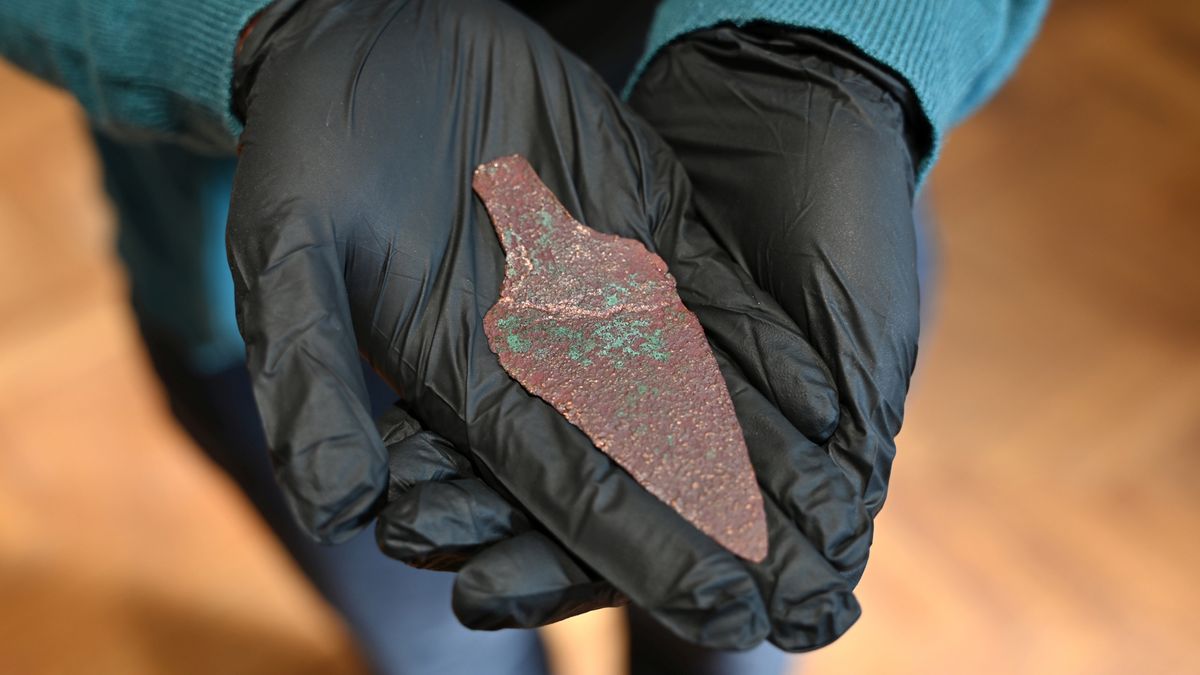
"The Korzenica dagger is so far the oldest metal dagger discovered [in] south-eastern Poland," said Marcin Burghardt, an archaeologist at the Orsetti Tenement House Museum in Poland who analyzed the dagger. "The only similar dagger in Poland was uncovered in the [1960s] so the new find comes as a great surprise," Burghardt [said].
A team went to examine the spot where the metal detectorist discovered the dagger but found no other artifacts.
Archaeologists were able to date the dagger by comparing it to similar daggers found in Central Europe and the Ukrainian forest steppe that have been securely dated. Based on the comparisons, "it seems safe to say that the Korzenica dagger was used somewhere in the [second] half of the 3rd millennium BC.”
https://www.livescience.com/archaeo...gger-unearthed-by-metal-detectorist-in-poland
maximus otter
A metal detectorist has discovered a 4,000-year-old copper dagger, likely from an elite warrior, in a forest near the village of Korzenica in southeast Poland.

"The Korzenica dagger is so far the oldest metal dagger discovered [in] south-eastern Poland," said Marcin Burghardt, an archaeologist at the Orsetti Tenement House Museum in Poland who analyzed the dagger. "The only similar dagger in Poland was uncovered in the [1960s] so the new find comes as a great surprise," Burghardt [said].
A team went to examine the spot where the metal detectorist discovered the dagger but found no other artifacts.
Archaeologists were able to date the dagger by comparing it to similar daggers found in Central Europe and the Ukrainian forest steppe that have been securely dated. Based on the comparisons, "it seems safe to say that the Korzenica dagger was used somewhere in the [second] half of the 3rd millennium BC.”
https://www.livescience.com/archaeo...gger-unearthed-by-metal-detectorist-in-poland
maximus otter
Steven
A tribute act to Sweep
- Joined
- Nov 5, 2023
- Messages
- 1,102
- Location
- UK
England’s largest gold nugget found in Shropshire with faulty metal detector
Richard Brock arrived late at detectorists’ outing, but within 20 minutes had found Hiro’s Nugget, likely to be worth over £30,000

https://www.theguardian.com/uk-news...ound-in-shropshire-with-faulty-metal-detector
Richard Brock arrived late at detectorists’ outing, but within 20 minutes had found Hiro’s Nugget, likely to be worth over £30,000
https://www.theguardian.com/uk-news...ound-in-shropshire-with-faulty-metal-detector
Bad Bungle
Tutti but not Frutti.
- Joined
- Oct 13, 2018
- Messages
- 4,132
- Location
- The Chilterns
Bad Bungle
Tutti but not Frutti.
- Joined
- Oct 13, 2018
- Messages
- 4,132
- Location
- The Chilterns
Swifty
doesn't negotiate with terriers
- Joined
- Sep 15, 2013
- Messages
- 33,695
The Knee of DestinyAnother little Roman coin from last week - a 'common' Camp Gate (get you) from Constantine the Great (~325 AD) that came up well with a little rubbing on the Knee of Destiny. Also another crotal bell (late 18th C) and my first sleigh bell, battered but both are ringers.
View attachment 75507 View attachment 75508View attachment 75513 View attachment 75514
Mythopoeika
I am a meat popsicle
- Joined
- Sep 18, 2001
- Messages
- 51,695
- Location
- Inside a starship, watching puny humans from afar
Are the coins lead or silver?Another little Roman coin from last week - a 'common' Camp Gate (get you) from Constantine the Great (~325 AD) that came up well with a little rubbing on the Knee of Destiny. Also another crotal bell (late 18th C) and my first sleigh bell, battered but both are ringers.
View attachment 75507 View attachment 75508View attachment 75513 View attachment 75514
Bad Bungle
Tutti but not Frutti.
- Joined
- Oct 13, 2018
- Messages
- 4,132
- Location
- The Chilterns
Small change is generically called Roman bronzes ie no silver, but looks shiny given how long it has been in the ground for.Are the coins lead or silver?
maximus otter
Recovering policeman
- Joined
- Aug 9, 2001
- Messages
- 13,981
400-year-old battle gear discovered by metal detectorist in Poland: 'Unique find'
A metal detectorist recently discovered 400-year-old military artifactswhile roaming around a field last month.
Patryk Chmielewski, who posts videos under the username Profesor Detektorysta, recorded himself walking through a dirt field in Mikułowice, Poland, in March. When his metal detector suddenly started pinging, he set up his camera and began digging in the soil.

Soon enough, Chmielewski uncovered several pieces of metal that were buried 60 centimeters deep. Around a week later, officials from the Ministry of Science and Higher Education announced the discovery.
Archaeologists believe that the armor belonged to the Polish hussars, a cavalry unit in the Polish–Lithuanian Commonwealth from the early 16th century to the early 18th century.
https://apple.news/ARG7oWPGOR5OzMSPQgRtg8A
maximus otter
A metal detectorist recently discovered 400-year-old military artifactswhile roaming around a field last month.
Patryk Chmielewski, who posts videos under the username Profesor Detektorysta, recorded himself walking through a dirt field in Mikułowice, Poland, in March. When his metal detector suddenly started pinging, he set up his camera and began digging in the soil.

Soon enough, Chmielewski uncovered several pieces of metal that were buried 60 centimeters deep. Around a week later, officials from the Ministry of Science and Higher Education announced the discovery.
Archaeologists believe that the armor belonged to the Polish hussars, a cavalry unit in the Polish–Lithuanian Commonwealth from the early 16th century to the early 18th century.
https://apple.news/ARG7oWPGOR5OzMSPQgRtg8A
maximus otter
Bad Bungle
Tutti but not Frutti.
- Joined
- Oct 13, 2018
- Messages
- 4,132
- Location
- The Chilterns
Gold and old silver go down great on Youtube clips but these are not common finds for the typical detectorist and it is usually bits that barely escape the scrap-pouch that saves the day. Anyway, three finds (not Youtube worthy) from last week.
The first are shotgun cartridges (shotties), the bane of a modern detectorist as they give a good signal (brass cap) so you have to dig them just in case they're something else. But the two shown are pinfire cartridges, invented by Monsieur Lefaucheux in 1832 whereby the gun hammer hits the pin on the side of the cap (as pic). This marked the rapid transition from muzzle loading guns (ammo loaded from front of barrel) to the quicker and safer breech loaders (ammo loaded at rear of barrel). The English sportsmen resolutely ignored pinfire guns at first for the obvious reasons that they were (i) not traditional and (ii) invented by a Frenchman. However after the Great Exhibition of 1851 the pinfires gained popularity until the late 1860s. After that pin-less centre fire cartridges took over as these were less likely to go off in your pouch or pocket whilst juggling small change.
Second item is a lead bag seal, a mainstay find indicating the contents of a sack (not GUANO for a change) and is specifically a folded four disc alnage seal. I had to look up alnage, the duty applied to a bundle of woollen cloth after inspection of quality and quantity by a Crown appointed alnager. If only there was some-one on the Forum who knows about the medieval woollen trade. One disc shows Britannia holding an olive branch with a 3 (threepence duty) and the opposite disc probably has the Monarch's monogram (GR). On the back is the head of George I (1714-24) and opposite him would usually be a number indicating ells of cloth in the bundle the alnage was applied to. Pleasing find.
Third is a copper alloy coin - this really threw me when I saw the Prince of Wales feathers and The Garter logo (Honi soit qui mal y pense) on one muddy side and Victoria Queen of Great Brit (sic) on the opposite. This is a gaming token or 'play money', the Victorians being demons for a round of Whist.
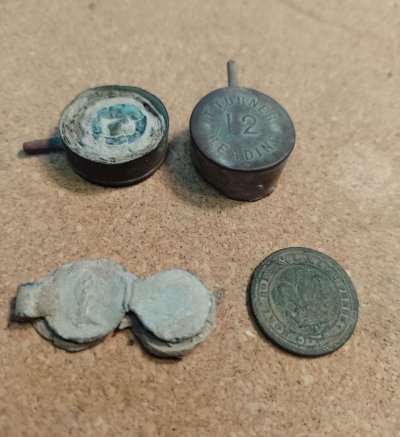
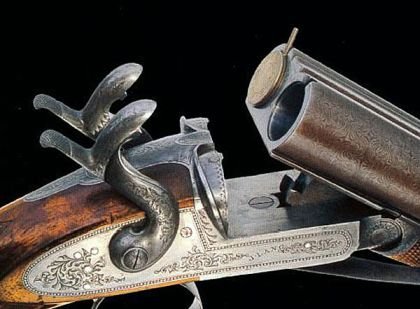
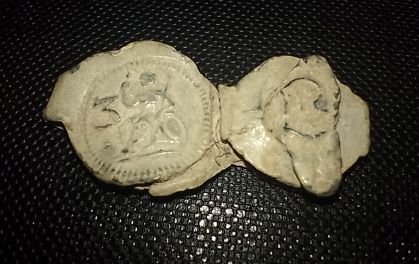
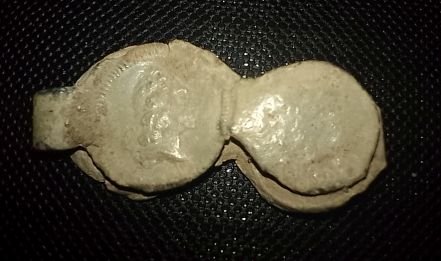
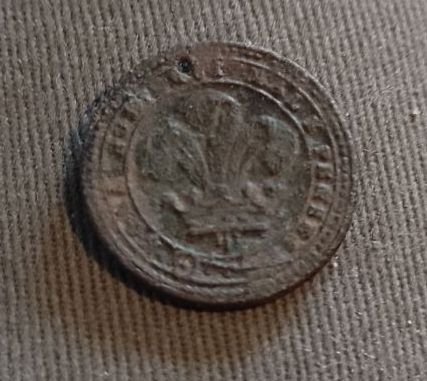
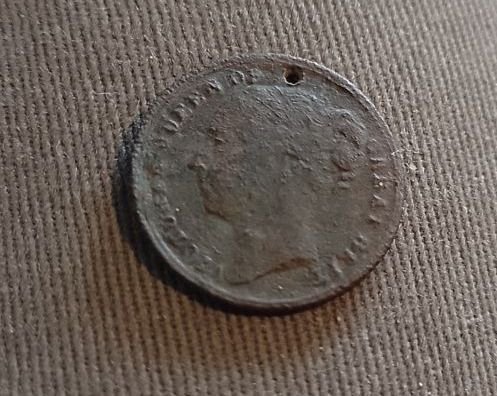
The first are shotgun cartridges (shotties), the bane of a modern detectorist as they give a good signal (brass cap) so you have to dig them just in case they're something else. But the two shown are pinfire cartridges, invented by Monsieur Lefaucheux in 1832 whereby the gun hammer hits the pin on the side of the cap (as pic). This marked the rapid transition from muzzle loading guns (ammo loaded from front of barrel) to the quicker and safer breech loaders (ammo loaded at rear of barrel). The English sportsmen resolutely ignored pinfire guns at first for the obvious reasons that they were (i) not traditional and (ii) invented by a Frenchman. However after the Great Exhibition of 1851 the pinfires gained popularity until the late 1860s. After that pin-less centre fire cartridges took over as these were less likely to go off in your pouch or pocket whilst juggling small change.
Second item is a lead bag seal, a mainstay find indicating the contents of a sack (not GUANO for a change) and is specifically a folded four disc alnage seal. I had to look up alnage, the duty applied to a bundle of woollen cloth after inspection of quality and quantity by a Crown appointed alnager. If only there was some-one on the Forum who knows about the medieval woollen trade. One disc shows Britannia holding an olive branch with a 3 (threepence duty) and the opposite disc probably has the Monarch's monogram (GR). On the back is the head of George I (1714-24) and opposite him would usually be a number indicating ells of cloth in the bundle the alnage was applied to. Pleasing find.
Third is a copper alloy coin - this really threw me when I saw the Prince of Wales feathers and The Garter logo (Honi soit qui mal y pense) on one muddy side and Victoria Queen of Great Brit (sic) on the opposite. This is a gaming token or 'play money', the Victorians being demons for a round of Whist.








